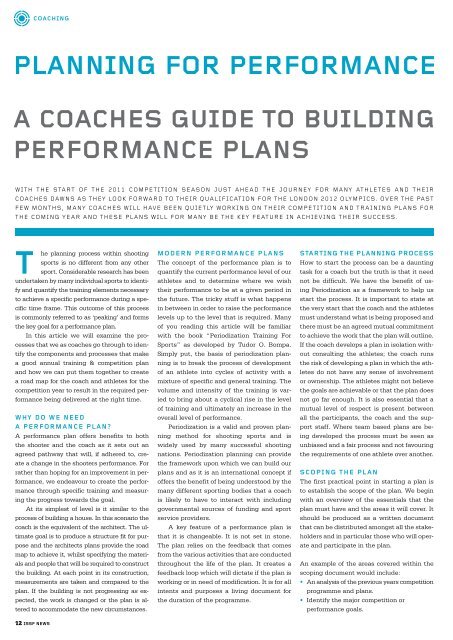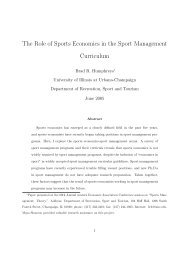You also want an ePaper? Increase the reach of your titles
YUMPU automatically turns print PDFs into web optimized ePapers that Google loves.
COACHING<br />
PLANNING FOR PERFORMANCE<br />
A COACHES GUIDE TO bUILDING<br />
PERFORMANCE PLANS<br />
With the start of the <strong>2011</strong> competition season just ahead the journey for many athletes and their<br />
coaches daWns as they look forWard to their qualification for the london 2012 olympics. over the past<br />
feW months, many coaches Will have been quietly Working on their competition and training plans for<br />
the coming year and these plans Will for many be the key feature in achieving their success.<br />
T<br />
he planning process within shooting<br />
sports is no different from any other<br />
sport. Considerable research has been<br />
undertaken by many individual sports to identify<br />
and quantify the training elements necessary<br />
to achieve a specific performance during a specific<br />
time frame. This outcome of this process<br />
is commonly referred to as ‘peaking’ and forms<br />
the key goal for a performance plan.<br />
<strong>In</strong> this article we will examine the processes<br />
that we as coaches go through to identify<br />
the components and processes that make<br />
a good annual training & competition plan<br />
and how we can put them together to create<br />
a road map for the coach and athletes for the<br />
competition year to result in the required performance<br />
being delivered at the right time.<br />
WHy DO WE NEED<br />
A PERFORMANCE PLAN?<br />
A performance plan offers benefits to both<br />
the shooter and the coach as it sets out an<br />
agreed pathway that will, if adhered to, create<br />
a change in the shooters performance. For<br />
rather than hoping for an improvement in performance,<br />
we endeavour to create the performance<br />
through specific training and measuring<br />
the progress towards the goal.<br />
At its simplest of level is it similar to the<br />
process of building a house. <strong>In</strong> this scenario the<br />
coach is the equivalent of the architect. The ultimate<br />
goal is to produce a structure fit for purpose<br />
and the architects plans provide the road<br />
map to achieve it, whilst specifying the materials<br />
and people that will be required to construct<br />
the building. At each point in its construction,<br />
measurements are taken and compared to the<br />
plan. If the building is not progressing as expected,<br />
the work is changed or the plan is altered<br />
to accommodate the new circumstances.<br />
12 ISSF NEWS<br />
MODERN PERFORMANCE PLANS<br />
The concept of the performance plan is to<br />
quantify the current performance level of our<br />
athletes and to determine where we wish<br />
their performance to be at a given period in<br />
the future. The tricky stuff is what happens<br />
in between in order to raise the performance<br />
levels up to the level that is required. Many<br />
of you reading this article will be familiar<br />
with the book “Periodization Training For<br />
Sports” as developed by Tudor O. Bompa.<br />
Simply put, the basis of periodization planning<br />
is to break the process of development<br />
of an athlete into cycles of activity with a<br />
mixture of specific and general training. The<br />
volume and intensity of the training is varied<br />
to bring about a cyclical rise in the level<br />
of training and ultimately an increase in the<br />
overall level of performance.<br />
Periodization is a valid and proven planning<br />
method for shooting sports and is<br />
widely used by many successful shooting<br />
nations. Periodization planning can provide<br />
the framework upon which we can build our<br />
plans and as it is an international concept if<br />
offers the benefit of being understood by the<br />
many different sporting bodies that a coach<br />
is likely to have to interact with including<br />
governmental sources of funding and sport<br />
service providers.<br />
A key feature of a performance plan is<br />
that it is changeable. It is not set in stone.<br />
The plan relies on the feedback that comes<br />
from the various activities that are conducted<br />
throughout the life of the plan. It creates a<br />
feedback loop which will dictate if the plan is<br />
working or in need of modification. It is for all<br />
intents and purposes a living document for<br />
the duration of the programme.<br />
STARTING THE PLANNING PROCESS<br />
How to start the process can be a daunting<br />
task for a coach but the truth is that it need<br />
not be difficult. We have the benefit of using<br />
Periodization as a framework to help us<br />
start the process. It is important to state at<br />
the very start that the coach and the athletes<br />
must understand what is being proposed and<br />
there must be an agreed mutual commitment<br />
to achieve the work that the plan will outline.<br />
If the coach develops a plan in isolation without<br />
consulting the athletes; the coach runs<br />
the risk of developing a plan in which the athletes<br />
do not have any sense of involvement<br />
or ownership. The athletes might not believe<br />
the goals are achievable or that the plan does<br />
not go far enough. It is also essential that a<br />
mutual level of respect is present between<br />
all the participants, the coach and the support<br />
staff. Where team based plans are being<br />
developed the process must be seen as<br />
unbiased and a fair process and not favouring<br />
the requirements of one athlete over another.<br />
SCOPING THE PLAN<br />
The first practical point in starting a plan is<br />
to establish the scope of the plan. We begin<br />
with an overview of the essentials that the<br />
plan must have and the areas it will cover. It<br />
should be produced as a written document<br />
that can be distributed amongst all the stakeholders<br />
and in particular those who will operate<br />
and participate in the plan.<br />
An example of the areas covered within the<br />
scoping document would include:<br />
• An analysis of the previous years competition<br />
programme and plans.<br />
• Identify the major competition or<br />
performance goals.

















